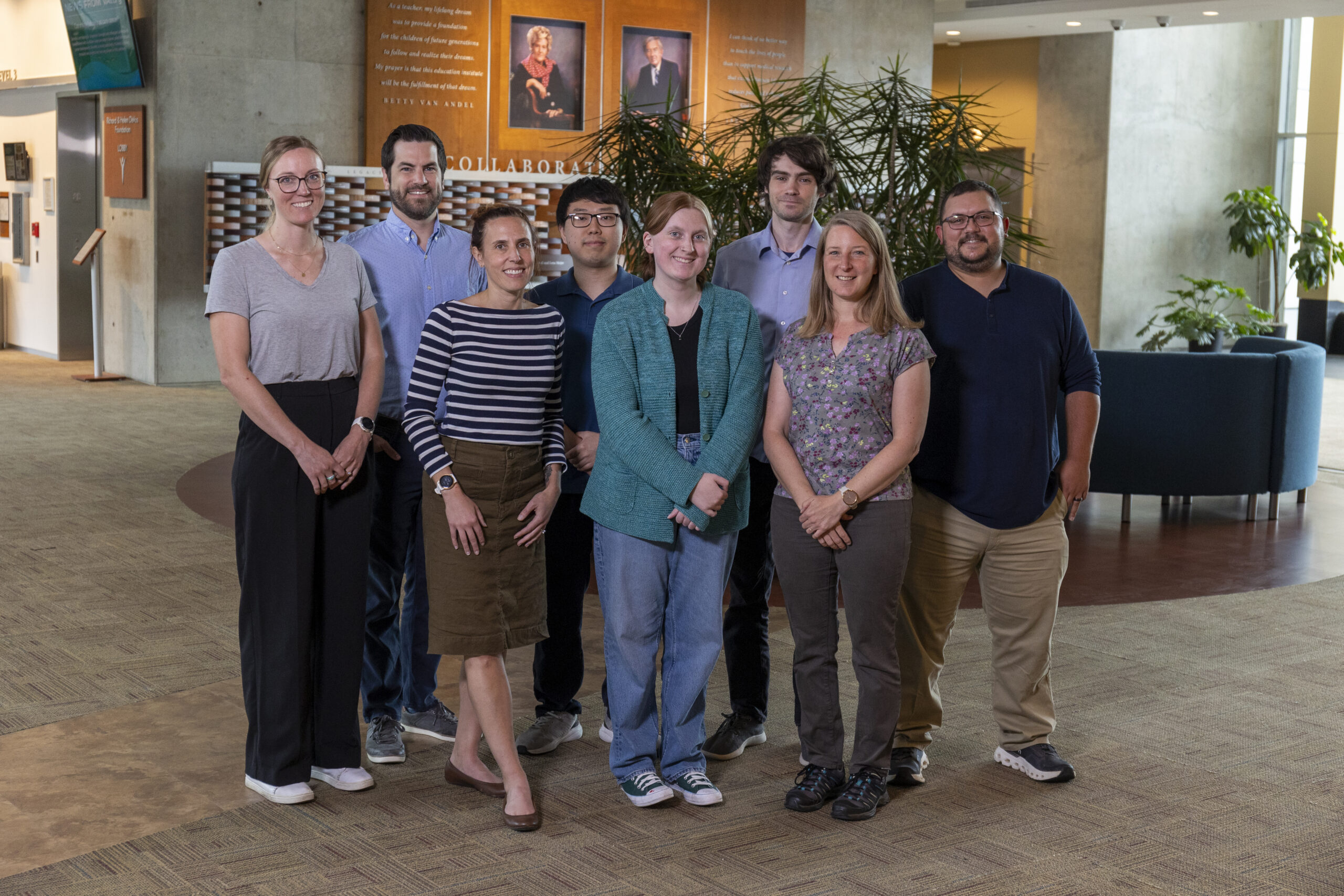Genomics Core
Van Andel Institute’s Genomics Core provides a comprehensive suite of genomics services to investigators at the Institute and beyond.
VAI’s Genomics Core uses ThirdWave Analytics Lockbox LIMS to facilitate project creation, submit sample information and track existing projects.
Request Genomics, Infinium, and Single Cell Sequencing Services
Spatial Collaborative Services combines expertise and technology from VAI’s Genomics Core and Optical Imaging Core to offer investigators a seamless pipeline for spatial imaging.For questions, please email [email protected].
Our Impacts
We’re raising thousands to save millions.
We’re turning hope into action for the millions of people around the world affected by diseases like cancer and Parkinson’s. Find out how you can help us make a difference.
- 121 peer-reviewed papers published in 2023
- 62 peer-reviewed papers published in high-impact journals in 2023
- 55 clinical trials launched to date
Services
The Genomics Core prides itself on conducting high-caliber science and providing exceptional customer service. For questions and pricing information, or to submit a service request, please email [email protected]. For more information on requesting services, please scroll down.
SEQUENCING
10X Chromium single cell RNA sequencing
Ideal for measuring expression levels and dissecting cell types in thousands of single cells in a cost-effective manner.
10X Chromium linked read sequencing
Provides pseudo-long read whole genome and targeted sequencing to help resolve large scale genomic architecture and scaffolding, long-range haplotyping and structural variant detection.
Whole-genome sequencing
Whole-genome sequencing gives scientists the ability to comprehensively study the genome by providing a complete look at an organism’s genetic information.
Custom targeted sequencing
Targeted sequencing allows scientists to isolate and sequence a specific set of genes or areas of the genome, reducing cost and time to results as well as providing a more precise data set.
Exome sequencing
The majority of disease-associated variants are found in the exome, the region of the genome responsible for protein-coding. A type of targeted sequencing, exome sequencing gives scientists the ability to focus on genes that are more likely to be associated with a phenotype of interest while providing a faster and more cost effective alternative when whole-genome sequencing is not required.
Methylation sequencing
Focusing on CpG and enhancer-rich regions of the genome, methylation sequencing is aimed at determining epigenetic information in a more targeted, cost effective manner, when whole genome information is not necessary
Bisulfite sequencing (RRBS/WGBS)
Bisulfite sequencing interrogates the epigenetic information contained and mediated by cytosine modifications such as methylation (5mC) and hydroxymethylation (5hmC). Both reduced-representation and whole genome bisulfite sequencing options are available.
RNA-seq
RNA-seq is a precise method for analyzing the transcriptome, and provides quantitative as well as qualitative data.
ChIP-Seq
IP sequencing allows researchers to look at the specific extrachromosomal modifications (transcription factors, histone modifications) that affect gene accessibility, transcription and translation.
RIP-seq
Sequencing of actively transcribed regions of the RNA polymerase complex allows researchers to assess actively transcribed regions under specific growth conditions.
GENOTYPING
Illumina Bead Arrays
Using the iScan platform, the Illumina bead arrays allow for cost-effective interrogation of millions of unique genomic sites. Commonly run array types include: QC array, EPIC methylation array. Projects are expedited by automation on the Tecan Freedom EVO liquid handler
Real-time PCR
A staple of biomedical research, real-time PCR amplifies and analyzes specific RNAs to aid in the study of gene expression.
Digital droplet PCR
Much like real-time PCR, the digital droplet is used to study gene expression but has the added ability to partition samples on a large scale while also requiring less sample volume.
HOW TO REQUEST SERVICES
Prior to requesting genomics services, please review the appropriate submission policies found here. All requests should be submitted via email to [email protected] along with the completed, requisite form, which may be found below. Core staff will add the service request to CrossLab.
VAI staff that need a login (or further CrossLab support) should contact Lori Moon. MSU and external users that need a CrossLab account/login should go here for account creation. After logging in, external users should click “list all cores” under the Core Facilities section in the left menu and scroll down to “Cores at Van Andel Institute.”
For more information, please email [email protected].
Equipment
The Genomics Core is home to state-of-the-art equipment and expert staff who provide a range of genomics services to internal and external users. Please email [email protected] for more information.
Illumina NextSeq 500
A flexible sequencing system appropriate for small/mid-range RNAseq, ChIPseq and other next-generation sequencing applications
Illumina NovaSeq 6000
A high-throughput system for large-scale genomic, epigenomic and transcriptomic studies.
Illumina iScan with Tecan Freedom EVO
A high-throughput genotyping system that can assay 288 individuals in a single run. Assays include:
- Infinium EPIC methylation array
- QC array
- MultiEthnicGlobal array
- Omni SNP genotyping arrays
10X Genomics Chromium
A nano droplet-based library preparation system that is useful for high-throughput single cell 3′ RNA expression analysis of single cell ATAC-seq and single cell immune profiling. Linked-read DNA analysis can provide structural and CNV information from genomics samples.
Shared equipment for walk-up use
The Genomics Core also provides a suite of shared equipment for walk-up use for well-trained, internal users. For questions or to set up training, please email [email protected].
Covaris LE220 Sonicator
Optimized for high-throughput, pre-analytical sample processing, including:
- DNA shearing for next-gen sequencing
- Cell lysis
- Tissue disruption
- Compound dissolution
BioRad CFX384 Well qPCR System
Offers a 384-well format with four-color detection optics for singleplex or multiplex reactions.
Qubit 2.0 Fluorometer
Provides accurate and sensitive DNA, RNA, and protein quantitation that is ideal for low concentration samples and samples entering next-gen sequencing library preparation.
Advanced Analytical Fragment Analyzer
Provides DNA and RNA quality and integrity analysis in a high throughput manner. Up to 288 samples can be analyzed at once.
BioRad Droplet Digital PCR
Absolute quantification of DNA or RNA PCR targets at single-copy resolution. Useful for:
- Rare target enrichment
- Copy number variation
- Mutation detection
- Gene expression analysis
- DNA methylation detection
VAI Genomics Core Policies
Please see the below PDFs for guidelines on genomics best practices and core policies.
WEB RESOURCES
Illumina Sequencing (KAPA QPCR, hyperprep, totalRNA, mRNA protocols)
Illumina Library Preparation
- KAPA Hyper Prep Kits (product information)
- KAPA ribosomally reduced RNA (product information)
- KAPA stranded mRNA (product information)
- KAPA Library qPCR Quantification (product information)
Illumina iScan
10x Chromium Single Cell
- Cell Prep Guide
- Sample and Library Preparation
- Getting started with 10x genomics single cell products
10x Chromium Long Read
- High-molecular weight DNA extraction from fresh frozen tissue
- Genome and exome library preparation guides
Quantification/Qualification
- Nanodrop Assessment of DNA and RNA purity
- PicoGreen Fluorometric Quantitation
- PicoGreen Fluorometric Quantification with Biotek Plate Reader
- Qubit Fluorometric Quantification
- Quantifluor (Promega) Fluorometric Quantification
- RNA yield from standard tissue types
- SPRI bead cleanups (video)
Covaris LE220 Sonicator
PacBio
Acknowledgments and Authorship
All work performed by VAI’s Core Technologies and Services should be acknowledged or considered for co-authorship in scholarly reports, presentations, posters, papers and all other publications. Proper acknowledgment allows us to obtain financial and other support that enables us to provide and maintain high-quality support and services. By acknowledging shared resource facilities and instrumentation in publications, presentations and other research communications, you play a critical role in ensuring their continued availability and future development.
Example acknowledgments:
- We thank the Van Andel Institute Genomics Core (RRID:SCR_022913), especially [staff name], for their assistance with [technique/technology].
- This research was supported in part by the Van Andel Institute Genomics Core (Grand Rapids, MI) (RRID:SCR_022913).
SELECTED PUBLICATIONS
Xue Z*, Qin L*, Xuan H*, Luo K*, Huang M, Xie L, Su Y, Xu L, Harsh J, Dale B, Shi X, Chen X, Kaniskan JÜ, Jin J#, Wen H#. 2024. A potent and selective ENL degrader suppresses oncogenic gene expression and leukemia progression. Sci Adv 10(35).
** Core recognized in the acknowledgments
Goralski TM, Meyerdirk L, Breton L, Brasseur L, Kurgat K, DeWeerd D, Turner L, Becker K, Adams M, Newhouse DJ, Henderson MX. 2024. Spatial transcriptomics reveals molecular dysfunction associated with cortical Lewy pathology. Nat Commun 15:2642.
Patterson JR, Kochmanski J, Stoll AC, Kubik M, Kemp CJ, Duffy MF, Thompson K, Howe JW, Cole-Strauss A, Kuhn NC, Miller KN, Nelson S, Onyekpe C, Beck JS, Counts SE, Bernstein AI, Steece-Collier K, Luk KC, Sortwell CE. 2024. Transcriptomic profiling of early synucleinopathy in rats induced with preformed fibrils. npj Parkinsons Dis 10:7.
*Core included in acknowledgements
Sha Q, Fu Z, Escobar Galvis ML, Madaj Z, Underwood MD, Steiner JA, Dwork A, Simpson N, Galfalvy H, Rozoklija G, Achtyes EA, Mann JJ, Brundin L. 2023. Integrative transcriptome- and DNA methylation analysis of brain tissue from the temporal pole in suicide decedents and their controls. Mol Psych.
Madaj ZB, Dahabieh MS, Kamalumpundi V, Muhire B, Pettinga J, Siwicki RA, Ellis AE, Isaguirre C, Escobar Galvis ML, DeCamp L, Jones RG, Givan SA, Adams M, Sheldon RD. 2023. Prior metabolite extraction fully preserves RNAseq quality and enables integrative multi-omics analysis of liver metabolic response to viral infection. RNA Biol 20(1).
Reske JJ, Wilson MR, Armistead B, Harkins S, Peres C, Hrit J, Adams M, Rothbart SB, Missmer SA, Fazleabas AT, Chandler RL. 2022. ARID1A-dependent maintenance of H3.3 is required for repressive CHD4-ZMYND8 chromatin interactions at super-enhancers. BMC Biol 20(1):209.
Wilson MR, Reske JJ, Koeman J, Adams M, Joshi NR, Fazleabas AT, Chandler RL. 2022. SWI/SNF antagonism of PRC2 mediates estrogen-induced progesterone receptor expression. Cells 11(6):1000.
Wilson MR, Skalski H, Reske JJ, Wegener M, Adams M, Hostetter G, Hoffman HH, Bernard JJ, Bae-Jump VL, Teixeira JM, Chandler RL. 2022. Obesity alters the mouse endometrial transcriptome in a cell context-dependent manner. Reprod Biol Endocrinol 20(1):163.
Gedminas JM, Kaufman R, Boguslawski EA, Gross AC, Adams M, Beddows I, Kitchen-Goosen SM, Roberts RD, Grohar PJ. 2022. Lurbinectedin inhibits the EWS-WT1 transcription factor in desmoplastic small round cell tumor. Mol Cancer Ther 21(8):1296–1305.
Yang CH*, Fagnocchi L*, Apostle S, Wegert V, Casani-Galdón S, Landgraf K, Panzeri I, Dror E, Heyne S, Wörpel T, Chandler DP, Lu D, Yang T, Gibbons E, Guerreiro R, Brás J, Thomasen M, Grunnert LG, Vaag AA, Gillberg L, Grundberg, E, Conesa A, Körner A, PERMUTE, Pospisilik JA. 2022. Independent phenotypic plasticity axes define distinct obesity subtypes. Nat Metab.
*Co-first authorship
**Highlighted in News & Views
***The Core contributed to this work
Zhou W, Hinoue T, Barnes B, Mitchell O, Iqbal W, Lee SM, Foy KK, Lee KH, Moyer EJ, VanderArk A, Koeman JM, Ding W, Kalkat M, Spix NJ, Eagleson B, Pospisilik JA, Szabó PE, Bartolomei M, Vander Schaaf NA, Kang L, Wiseman AK, Jones PA, Krawczyk CM, Adams M, Porecha R, Chen BH, Shen H, Laird PW. Pre-print. DNA methylation dynamics and dysregulation delineated by high-throughput profiling in the mouse. bioRxiv.
Gupta R, Leimanis ML, Adams M, Bachmann AS, Uhl KL, Bupp CP, Hartog NL, Kort EJ, Olivero R, Comstock SS, Sanfilippo DJ, Lunt SY, Prokop JW, Rajasekaran S. In press. Balancing precision vs. cohort transcriptomic analysis of acute and recovery phase of viral bronchiolitis. Am J Physiol Lung Cell Mol Physio.
Grit JL, Johnson BK, Dischinger PS, Essenburg CJ, Adams M, Campbell S, Pollard K, Pratilas CA, Triche TJ Jr., Graveel CR, Steensma MR. 2021. Distinctive epigenomic alterations in NF1-deficient cutaneous and plexiform neurofibromas drive differential MKK/p38 signaling. Epi Chromatin 14(7).
Marshall LL, Killinger BA, Ensink E, Li P, Li KX, Cui W, Lubben N, Weiland M, Wang X, Gordevicius J, Coetzee GA, Ma J, Jovinge S, Labrie V. 2020. Epigenomic analysis of Parkinson’s disease neurons identifies Tet2 loss as neuroprotective. Nat Neuro.
George JW, Fan H, Johnson B, Carpenter TJ, Foy KK, Chatterjee A, Patterson AL, Koeman J, Adams M, Madaj ZB, Chesla D, Marsh EE, Triche TJ, Shen H, Teixeira JM. 2019. Integrated epigenome, exome, and transcriptome analyses reveal molecular subtypes and homeotic transformation in uterine fibroids. Cell Rep.
deCarvalho AC, Kim H, Poisson LM, Winn ME, Mueller C, Cherba D, Koeman J, Seth S, Protopopov A, Felicella M, Zheng S, Multani A, Jiang Y, Zhang J, Nam DH, Petricoin EF, Chin L, Mikkelsen T, Verhaak RGW. 2018. Discordant inheritance of chromosomal and extrachromosomal DNA elements contributes to dynamic disease evolution in glioblastoma. Nat Genet 50(5):708–717.
Herbert ZT, Kershner JP, Butty VL, Thimmapuram J, Choudhari S, Alekseyev YO, Fan J, Podnar JW, Wilcox E, Gipson J, Gillaspy A, Jepsen K, BonDurant SS, Morris K, Berkeley M, LeClerc A, Simpson SD, Sommerville G, Grimmett L, Adams M, Levine SS. 2018. Cross-site comparison of ribosomal depletion kits for Illumina RNAseq library construction. BMC Genomics 19:199.
Gaskell J, Blanchette RA, Stewart PE, BonDurant S, Adams M, Sabat G, Kersten P, Cullen D. 2016. Transcriptome and secretome analyses of the wood decay fungus Wolfiporia cocos support alternative mechanisms of lignocellulose conversion. Appl Environ Micro 82(13):3979–3987.
Baker EC, Wang B, Bellora N, Peris D, Hulfachor AB, Koshalek JA, Adams M, Libkind D, Hittinger CT. 2015. The genome sequence of Saccharomyces eubayanus and the domestication of lager-brewing yeasts. Mol Bio Evol 32: 2818-2831.
O’Grady T, Cao S, Strong MJ, Concha M, Wang X, BonDurant S, Adams M, Baddoo M, Srivastav SK, Lin Z, Fewell C, Yin Q, Flemington EK. 2014. Global bidirectional transcription of the Epstein-Barr Virus genome during reactivation. J Virology 88(3):1604–1616.
Newell MA, Vogel KE, Adams M, Aydin N, Bodnar AL, Ali M, Moran Lauter AN, Scott MP 2014. Genetic and biochemical differences in populations bred for extremes in maize grain methionine concentration. BMC Plant Bio 14:49.
Tromp DPM, Grupe DW, Oathes DJ, McFarlin DR, Hernandez PJ, Kral TRA, Lee JE, Adams M, Alexander AL, Nitschke JB. 2012. Reduced structural connectivity of frontolimbic pathway in generalized anxiety disorder. Arch Gen Psychiatry 69(9):925.
Robinson SJ, Samuel MD, Johnson CJ, Adams M, McKenzie DI. 2012. Emerging prion disease drives host selection in a wildlife population. Ecol Appl 22(3):1050–1059.
Kolb AW, Adams M, Cabot EL, Craven M, Brandt CR. 2011. Multiplex sequencing of seven ocular herpes virus type-1 genomes: phylogeny, sequence variability and SNP distribution. Invest Ophthalmol Vis Sci. 52(12):9061–9073.
Kerley-Hamilton JS, Shanker S, Geskes J, Nicolet CM, Wright C, Thimmaupram J, Adams M, Gaudenz K, Fleharty B, Couget J, Warner D, Herbert ZT, Grove DS, Chiuttur S, Wilcox E, Beckloff N, Levine SS. Inter-laboratory comparisons of DNA and RNA quality assessment. (white paper)


Marie Adams, M.S.
Director, Genomics Core

Tracey Avequin, B.S.
Core Associate, Genomics Core

Katelyn Becker, M.S.
Core Laboratory Manager, Genomics Core

Brandon Compton
Core Associate, Genomics Core

Brennan Grimes, B.S.
Core Associate, Genomics Core

Andrew Hankiewicz
Core Associate, Genomics Core

Michelle Minard, B.S.
Senior Administrative Assistant II

Marc Wegener, B.S.
Core Associate, Genomics Core

Yeong Yun
Core Technician, Genomics Core
Project Submission
VAI’s Genomics Core uses ThirdWave Analytics Lockbox LIMS to facilitate project creation, submit sample information and track existing projects. First-time users should first request a LIMS account by emailing [email protected].
To create a project or view an existing project, log in to the LIMS system here:
Lims LoginAfter project submission, samples can be brought to VAI either in person or shipped.
- In-person sample drop-off can be scheduled by emailing [email protected] and [email protected] with the date and time you would like to drop off your materials. Please provide at least one business day’s notice of your drop-off.
- Samples can be shipped on dry ice using an overnight courier such as FedEx. Place all samples in a secondary structural box. Please place a paper manifest in the shipping container and email any tracking information to [email protected]. Our shipping address is:
- Van Andel Institute Genomics Core
333 Bostwick Ave NE, Room 1211
Grand Rapids, MI 49503
